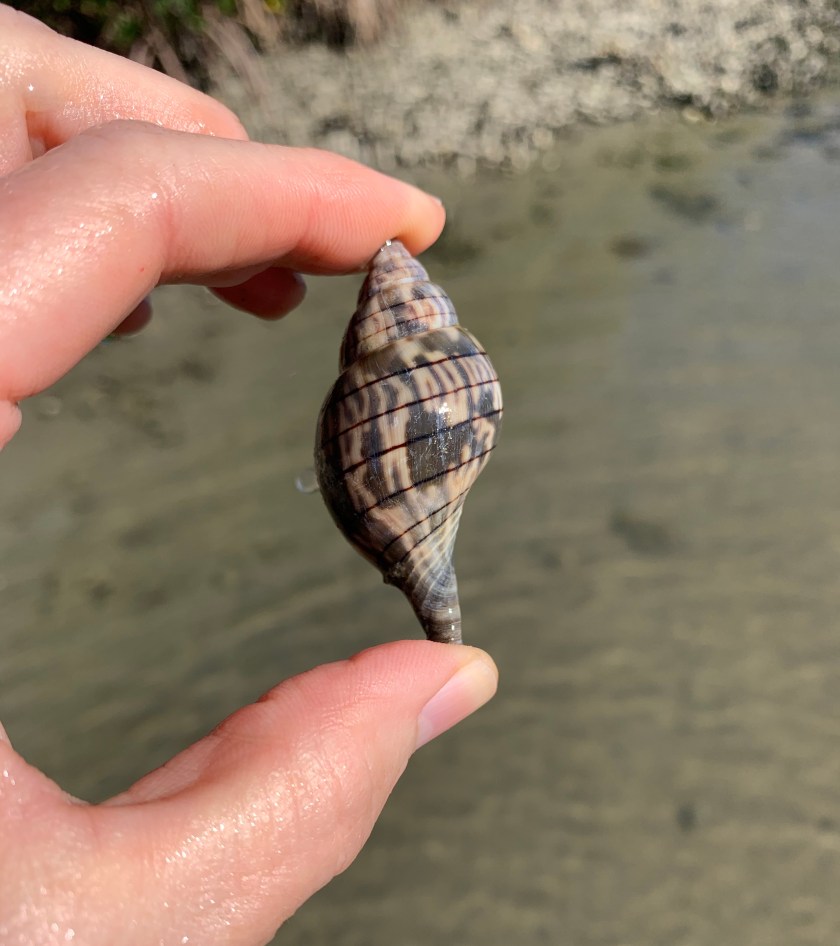Here are my photos of the shells I’ve come across while traveling the beaches and rivers of Florida’s East Coast. My beachcombing is mostly done in the backwaters of the Indian River in Florida, Mosquito Lagoon area, which is saltwater. I also visit the ocean beach and often find interesting shells and broken things at Ponce Inlet in New Smyrna Beach.
This page of my photography is of the most common seashells I see – some more common than others. Most shells I find are inhabited, by either the snail, or a hermit crab. In that case, I get photos and leave the shell where I found it.

Knobbed Whelks
(Busycon carica) are wide and thick with spaced points at the top of the whorl. Usually I only find pieces of this shell. Then, one day I came across this tan beauty! A big hermit crab had taken up residence so after the photo shoot, it went back into the water where I found it.

Knobbed Whelk 
A look inside the knobbed whelk 
Another view of the points around the top of this shell 

Worn horse conch with knobbed whelks 



Florida Horse Conch

(Triplofusus giganteus) is the largest snail in North America and is Florida’s state shell. The living snail is bright orange.
The spire differs between bumpy and smooth but it is always elongated.


The mature horse conch can be two feet long! Most often I find small specimens of this shell, which always contain hermit crabs. The larger, living whelk’s habitat is in shallow water with a sandy bottom in calm areas of the saltwater river.




Lightning Whelk
(Busycon sinistrum) is known for it’s left side opening. The whorl spirals left, not right as most shells.

The Lightning Whelk usually has beautiful brown coloring in streaks, hence it’s name.
This shell can be quite long, but the ones I see are about this size.



Shark’s Eye
(Neverita duplicata)
A pretty round, brownish shell with a center, blueish “eye”. Can be up to around 3 inches.



The Shark’s eye lays eggs mixed with sand to create a rubbery round disk. When I first found one of these, I thought it was someone’s trash! The shape ensures that they stay upright in one place until the baby Shark Eyes hatch.



Pear Whelk
(Busycotypus spiratus)
Similar in appearance to the Lightning Whelk, but with the opening on the right.




Channeled Whelk
(Busycotypus canaliculatus)The channeled whelk has little bumps around the spire. I rarely find them.





Crown Conchs
(Melongena corona)
Larger shells are easily identifiable by the pointy ridges along the top and a row around the bottom. The crown conch can have beautiful stripes and coloring.





Florida Fighting Conchs
(Strombus alatus)
A thick, chunky shell with shorter, knobby spire. Think, short and wide. I don’t see these shells very often.





Tulip Shells
Banded tulips (Fasciolaria ilium) have horizontal lines, such as the photos on the left. True tulips (Fasciolaria tulip) have an overall blotchiness. The tulips are Spindle shells which include the Horse Conch. They have long tops, or spires.




Dosinia
(Dosinia discus)
The Dosinia is a type of clam which is quite flat compared to other clams. I’ve found them in many sizes and they will grow to be around 3 inches. I have found this shell on ocean beaches as well as island sand.

Arks and Cockles
Bivalves which are commonly found on the ocean beaches. They can come in many colors, and have noticeable ribs.



This is not a comprehensive list, and most shells I photograph were found far from an ocean beach, but in the calmer river waters and little island beaches scattered throughout the marshy backwaters. I never collect any shells that have a living creature inside. It’s easy to see the living mollusk, but hermit crabs can easy tuck themselves way inside and make a shell seem to be empty. After bringing a couple of hermit crabs back home accidentally (and having to drive back to the water to return the shell) I now do not collect any gastropods, or one piece shell unless they are too small for hermits to inhabit (olive shells), or too large (big horse conchs).








